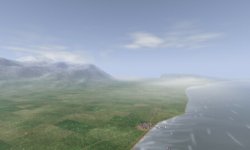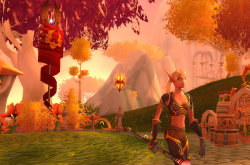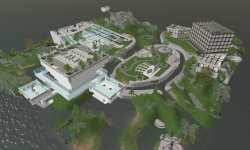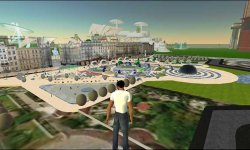Movies, computer games, and cyberspaces are probably the most common forms of virtual worlds people experience nowadays, although prehistoric cave paintings are also considered as an early expression of virtual reality.
When a virtual world is created for entertaining purposes, its designers often focus on its instant attractiveness, as well as on its ability to maintain the attention (or the involvement) of the spectator. A framework for the enjoyment evaluation of the video game player was proposed by Sweetser et al., 2005: the GameFlow model combines the following heuristics: concentration, challenge, skills, control, clear goals, feedback, immersion, and social interaction.
Supported by the media, video game editors started a technical race to increase the realism of the games (by incorporating landscape engine), thus improving the immersion potential of the virtual environment for the gamer. However, this latter point of realism may have been over-emphasized as Cheng et al., 2005 showed that realism and behavior of the graphics could be significantly changed without breaking the level of immersion of the players; or it may rather be a feature of western culture, whereas the graphics of the most popular games in Japan (half of the video games market) are not realistic but derive from a manga atmosphere. The level of immersion of a player is rather correlated to his feeling that the game or the machine is an extension of his body, thus leading to a new generation of games where players use their natural body movements and interact with each other (Strömberg et al., 2002). Since 2006, it has been possible to experience body gameplay on the Wii next-generation console.
Virtual landscape engines
The improvements in computing hardware and in modeling technologies allowed the development of virtual landscape engines and their availability for the end-users. The CryEngine2 is a game engine, specialized in designing and rendering natural and urban environments for video games, although it also contains a built-in physics engine. This new version of the engine is bound to be used in the upcoming Crysis video game (science-fiction first person shooter) and in the Entropia Universe massively multiplayer online game (see the MMORPG section of this page). Some official trailers are available, but the presentation below gives some interesting information and comments from the landscape designer point of view:
The presentation shows various features of CryEngine2 concerning graphical, physical, and animation technologies. The edition of the landscape is done in real-time. The second part of the demo continues on this video.
Havok and PhysX are two renowned real-time physics engines designed to create interactive and realistic physical environments. Such physical engines allow game developpers (and even movie special effects directors!) to design materials and the way they may interact with the player, whereas before, the developpers had to specify how the player may interact with its environment.
On the left is a demonstration of Havok abilities to model solid and flexible materials and their behaviors when being kicked (previews of the upcomping Star Wars game).
On the right is a demonstration of PhysX abilities to model liquid or smoke materials.
Game engines ease the design of realistic video games, but they also allow players to interact with their virtual environment, mainly to make most of it "breakable". However, implementating such interactions through realtime engines instead of pre-programmed animations gives more space and freedom to the player who can modify parts of the game environment and experience its new evolution. For example, check what this Oblivion player has done by using books and items to create this rocking Oblivion domino set. (Note: some other people experienced it in real life as well! Domino video for Restless Legs).
Virtual worlds are nothing without characters interacting in them! :)
Virtual networks
Virtual world technologies have recently collided with Web 2.0 technologies to create new applications in video games and in social networks.
Web2.0 is still an evolving concept, generally referring to websites which offer services, instead of only displaying information. Examples of Web2.0 services: news feeds, forums, calendars, office applications, map and travels drawing, project management tools, etc.
Web 2.0 sites being applications, one cannot predict how people will actually use them. This feature sometimes leads to the creation of another website which combines the services of other websites. Such websites are called mashups; a famous example is the combination of Estate agencies and Google Earth websites to display the view from a flat you are interested in renting.
MMORPG

Massive Muliplayer Online Role-Playing Games are role-playing games, which usually immerse a single human player in an extensively detailed universe filled with sceneries and non-human characters to interact with during quests and adventures, implemented on a web server to allow real-time interaction between different human players. Unpredictable interactions between so many actors of a MMORPG imply the integration of new communication functionnalities, identification possibilities, and narration elements.
While chat allows real-time "spoken" communication between players, some MMORPG like World of Warcraft (WoW) have incorporated other types of actions or communication like dancing or laughing/crying. Such functionnalities are not necessary to play the game, but they give a lot of freedom to the players to create their own fun within the MMORPG universe: some have organized in WoW wedding ceremonies or musical chairs! Some MMORPG have also integrated some grouping functionnalities for the players to be identified as a team and thus gaining the opportunity to solve quests a player wouldn't achieve alone.

More generally, MMORPG require to re-think quests and the environment dynamics when thousands of players can unpredictably share the same landscape and resources. If a player harvest some food or mine some iron to build equipment, when does the next harvest grow? Is the iron still available? How must the availibility of every types of resource be managed? The same issues rise for the quests: once a player has achieved a mission to get experience or any kind of rewards (money, equipment, information), what about the other players? Therefore, narration and the dynamics of such virtual worlds must be completely rethought.
Social networks
Whereas MMORPG virtual worlds give a context and some specific goals to the human actors, other types of web-based virtual worlds focusing on social interaction were created, where no purpose is given to the people entering the network, but interact. Social networks like Facebook or MySpace allow people to share their centers of interest (being business or leisure) through personal webpages combined with file-sharing, tagging and forum functionnalities.

SecondLife chose another way to create this environment dedicated to exchange, which seemed to me much more powerful and interesting, although there is no doubt that all these social networks are complemetary. SecondLife is indeed a whole 3D universe where people play a character they designed (such a virtual character is called an avatar). Through their avatar, people can create all kinds of object which can be imbued with physical behaviour thanks to the integrated Havok physical engine. It is also possible to build terrain, model the natural environment, and script the behaviour of objects (motions, colours, information displayed, etc.).

Beside the technological challenges coming along with such a project, it is really interesting and impressing to see how people have used this freedom to design their own applications ranging from leisure to professional activities. Virtual campus were created for e-learning activities, embassies (like Estony, Sweden) and companies have created their facilities as new ways of providing information or promoting their services. SecondLife was also used as a demonstration environment for architects to display their projects (design contest in SecondLife for the renovation of Les Halles garden in Paris) or clothes designer to show their creativity (fashion design and trade).
Virtual and real worlds - where is the fun?
My purpose is not to debate of the mutual risks of having fun in a real- or virtual-world environment, but to share my enthousiasm and my curiosity to the rise of new networking possibilities between humans. Virtual worlds have always fascinated humans through arts, religion or the construction of scientific theories; all sharing their loads of benefits, fun and abuses.
As for arts and religion, the interest of gaming virtual worlds takes its roots in the involvement of humans in their conceptual universe. Moreover, the build-up of a cultural identity is facilitated by the ability of a virtual world to emerge in the real world through material representations, like paintings or music pieces for instance. Therefore, it's not surprising that events like CosPlays, where people disguise themselves into video game characters, tend to be more and more popular in a context where this type of virtual gaming worlds is accessible in real-time to an increasing number of people. Such events give the opportunity to gather people around the same interests and build their own cultural identity.
Last update of the virtualworlds page: 10 January 2012-00:35.